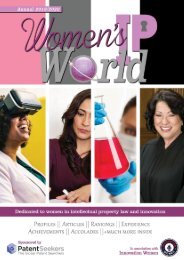Global IP Matrix - Issue 7
Dear readers, We sincerely hope that you are all in good health and keeping in good spirits during these undeniably uncertain times. We have all had to adapt to working out of our comfort zones, which I am sure has been very challenging at times for you all as it has been for us. However, we continue our quest to look to the future and deliver exclusive content to you, direct from thought leaders working at ground level in the IP industry from all over the world. Issue 7 of The Global IP Matrix magazine is packed with informative and exciting articles to keep you up to date and educated in what has been developing in the global IP industry during the past few months and into the future. We hope you enjoy reading our publication. We want to thank all our contributors for sharing their knowledge, opinions, and expertise in this new edition of the Global IP Matrix magazine. From all of us at The Global IP Matrix & Northon's Media, PR & Marketing Ltd
Dear readers,
We sincerely hope that you are all in good health and keeping in good spirits during these undeniably uncertain times. We have all had to adapt to working out of our comfort zones, which I am sure has been very challenging at times for you all as it has been for us.
However, we continue our quest to look to the future and deliver exclusive content to you, direct from thought leaders working at ground level in the IP industry from all over the world.
Issue 7 of The Global IP Matrix magazine is packed with informative and exciting articles to keep you up to date and educated in what has been developing in the global IP industry during the past few months and into the future. We hope you enjoy reading our publication.
We want to thank all our contributors for sharing their knowledge, opinions, and expertise in this new edition of the Global IP Matrix magazine.
From all of us at The Global IP Matrix & Northon's Media, PR & Marketing Ltd
You also want an ePaper? Increase the reach of your titles
YUMPU automatically turns print PDFs into web optimized ePapers that Google loves.
It is to be noted that the requirement of
a graphical representation is a condition
established by the Trademark laws of these
countries. Unfortunately, the Nigerian TMA
did not expressly provide for such. The
graphical representation is a consequence of
the Trademarks Regulations. Kerly brought
out the full fact and implications of the
Sieckmann case. He reported:
‘In Sieckmann, the application was to
register an olfactory mark comprising “the
pure chemical substance methyl cinnamate
(= cinnamic acid methyl ester),” and the
structural formula was provided: C6H5-
CH=CHCOOCH3. In addition, Mr.
Sieckmann gave details where one could
obtain the chemical, he submitted with his
application an odour sample of the sign in
a container and stated that the scent was
usually described as ‘balsamic, fruity with a
slight hint of cinnamon’. The ECJ answered
the various questions referred to it in the
following way. First, it stated that a trademark
might consist of a sign which is not in itself
capable of being perceived visually, provided
that it can be represented graphically.
Second, as far as the graphic representation
is concerned, it laid down the requirements
that it must be clear, precise, self-contained,
easily accessible, intelligible, durable, and
objective. Third, the ECJ stated that, in
respect of an olfactory sign, the requirements
of graphic representability are not satisfied
by a chemical formula, description in
written words, a deposit of an odour sample,
or a combination of those elements. 5
‘In the light of those emphatic statements, one
may ask: how else can one attempt to provide
a satisfactory graphic representation of an
olfactory mark? There are some possibilities
that Mr. Sieckmann did not put forward, such
as defining the odour by referencing accepted
standards of classification for odorants such
as Zwaardemaker. Still, it is very difficult
to find an alternative that would satisfy the
requirements laid down by the ECJ. The
practical effect of the Sieckmann judgement
is probably that it is impossible to obtain
a valid registration of an olfactory mark
unless or until the requirements for recording
the ‘sign’ in question are changed to allow
representations other than purely graphic or
descriptions in words’.
Kerly concluded that the same fate befalls a
taste mark. It is to be noted that the major
reason behind the graphical presentation is a
certainty. There must be a certainty to even a
layman as to what is sought to be registered.
The Way Forward
As far as signs/marks of smell and
taste are concerned in foreign
countries, the ECJ has made their
registration almost practically
impossible. That fate, however, is
not and should not be the same for
Nigeria. First, our deduction of the
‘graphical requirement’ is traced to the
Regulation, which can be amended
easily by the Minister of Trade and
Commerce. Secondly, it is my hope
that the IPCOM bill sought to be
passed would redefine the meaning
of a mark and trademark to include
smells and taste. That way, many of
the problems on restraint of trade
will be alleviated if not totally solved;
proprietors can be fully protected,
and employees/traders can enjoy
the fullness of their rights to work/
trade.
Kerly went on to provide his view on the
matter on pages 17-18:
1 Section 67, TMA.
2 Section 5, 11, 13 TMA
3 Cornish, Llewelyn, and Aplin, Intellectual Property:
Patents, Copyright, Trademarks and Allied Rights
(7 edn: Sweet & Maxwell) 2010, p. 738 paras. 18-34..
4 Gary Lea & Peter Cornford, Trade Marks: law and
practice (3rd edn: Jordans, 2012) Pp. 27-28.
5 Kerly’s Law of Trade Marks and Trade Names
(14th, edn: Thomson; Sweet & Maxwell) 2005, p. 7
14 www.gipmatrix.com www.gipmatrix.com
15












